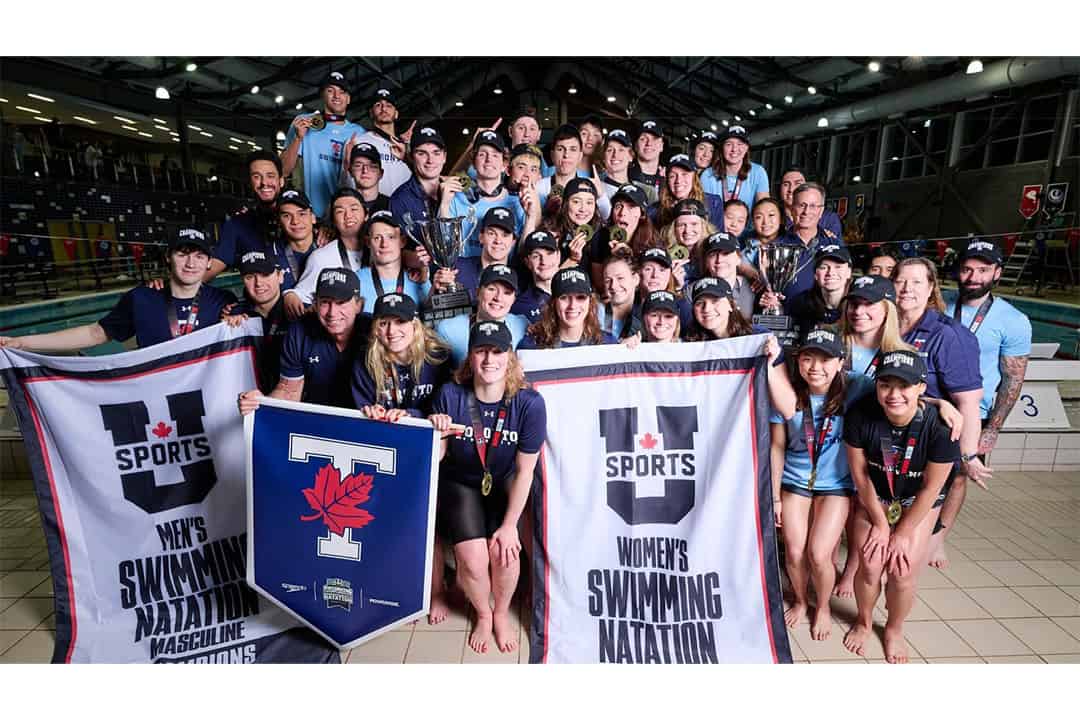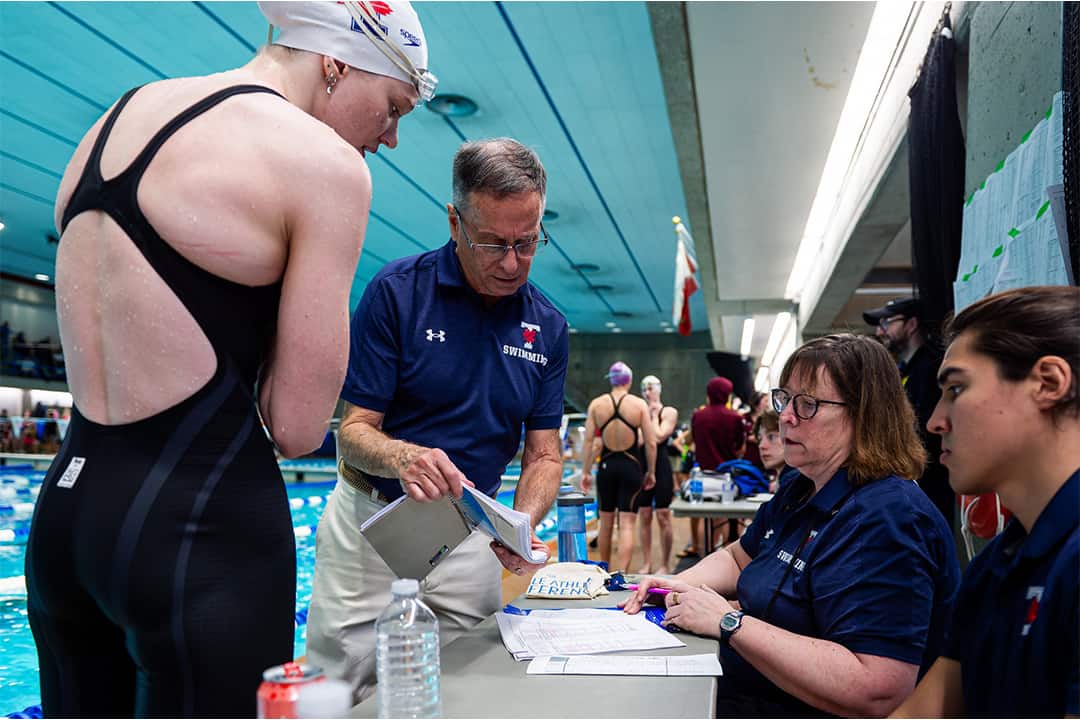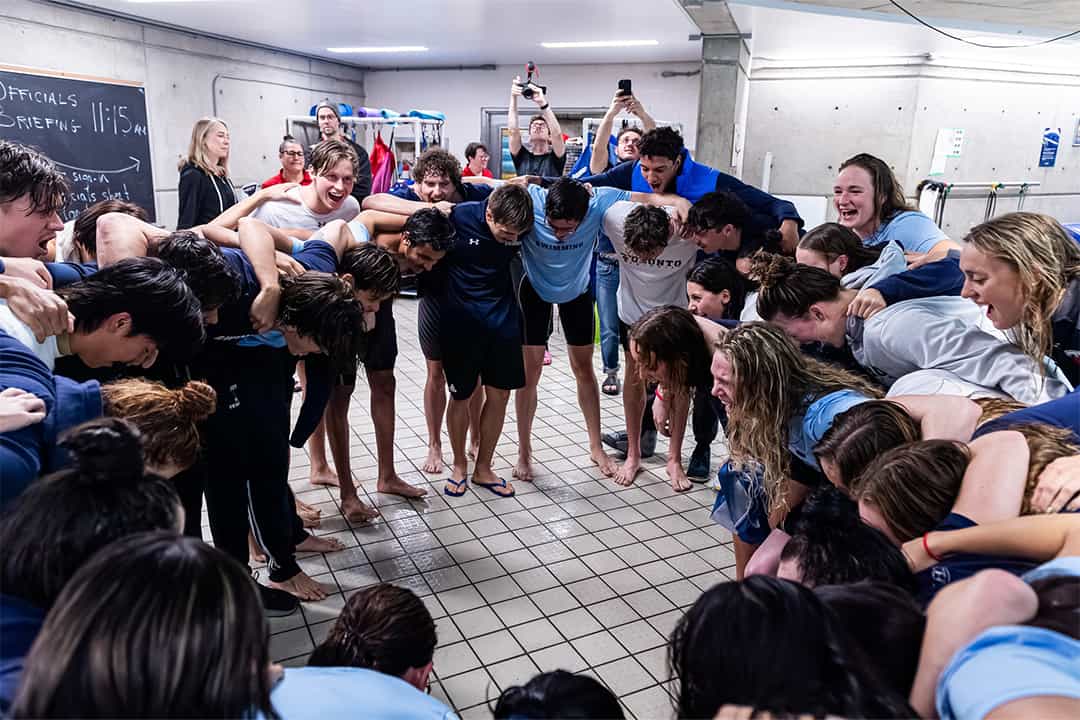On March 9, after three days of swimming competitions in Montréal, the Varsity Blues swim team won both the men’s and women’s respective U SPORTS Championships. This was their third women’s championship victory in a row and 18th overall since their inception, and their first men’s win since 2016 and their 20th overall.
While every swimmer is now heading back to Toronto with a gold medal, there were several standout performers for the Blues in Montréal.
Masters student and swimmer Ainsley McMurray earned seven medals — four golds, one silver, and two bronze. Blues rookie Bill Dongfang won two gold medals — setting a U SPORTS record (2:00.85) in the 200-metre butterfly — and three silver medals.
Second-year swimmer Nina Mollin claimed three gold medals in individual events, one on each day, ending the competition with four golds and one bronze. Fellow sophomore Benjamin Loewen also shined, taking one gold, two silvers, and one bronze. Head coach Byron MacDonald also won the 2023–2024 U SPORTS Men’s Coach of the Year Award.
Overall, the conclusion of the U SPORTS Championship marks the end of another magnificent Varsity Blues swimming season. Earlier this year, on February 18, the Blues had equal provincial success, winning the Ontario University Athletics Championships at Brock University — the 20th consecutive title for the men and the 10th consecutive title for the women.
Yet, the Blues remain hungry for more medals and there is no reason to believe that they cannot accomplish that with their history of dominating their competition. But how can the past, present, and future success of the team be explained?
Good recruitment has been one of the keys to the Blues’ victories. “[You can] have the best coaching in the world, [but] if there’s no talent, the team is not going to succeed,” MacDonald said. According to MacDonald, two factors — U of T’s strong history of both academic and swimming success — explain why so many talented swimmers choose to compete with the Varsity Blues.
Student first, athlete second
Academics are the first big factor to explain why swimmers join the Blues. “When you finish your swimming career, it’s accompanied [by] an amazing degree from [U of T],” explained McMurray.
Compared to athletes in sports like soccer or hockey, swimmers don’t have a professional league that they can compete in as professional athletes. As a result, many swimmers understand that competing at the university level might be their last opportunity, so they also want to receive a degree from an established institution. “Building those transferable skills that you can then translate into a successful career [is important],” Mahaylia Datars, a fourth-year swimmer, said.
The swimming program supports its student-athletes in all their endeavours. “One of the big things that I was told about U of T that really resonated with me was that you’re a student-athlete, [so] you’re a student first [and then] an athlete second,” McMurray said. It’s also something that the coaches emphasize at the start of each year.
While the team hosts 13 practices a week, the team isn’t required to attend all of them. In fact, unlike many universities in the United States, there isn’t a minimum number of practices a swimmer has to attend to maintain their place on the team. During exam season, the schedule becomes more lenient, allowing swimmers to miss practices if they have to study for exams or finish assignments.
“Swimming is a very demanding sport… but [the coaches] recognize how [academically tough] U of T is,” Loewen explained. Additionally, according to McMurray, the academic ambitions and goals that permeate throughout the team have also helped make them better swimmers and a better team.
A cycle of success
Ultimately, the swimmers still want to compete, so according to MacDonald they also look for a university with “a good swimming program.” With a combined total of 48 national titles and 104 provincial titles across both men’s and women’s championships, the Blues have a great history of success — the best across Canadian universities.
MacDonald has been a big part of that historical success. A former Olympian at the 1972 Olympic Games, MacDonald became the new head coach of the Varsity Blues men’s swim team in 1978, and five years later, he began coaching the women’s team as well.
46 years later, MacDonald is still with the Varsity Blues. “Thank God, the government… decided to eliminate the mandatory retirement law, because otherwise, I would [be done],” MacDonald said with a laugh. “That would have been crushing simply because I absolutely love [coaching].”
In 1990, MacDonald was joined by Linda Kiefer as his associate head coach. A Varsity Blues alum, Kiefer has now worked with MacDonald for 34 years and is Canada’s highest-ranked women’s swimming coach. “Byron and Linda… have built [an] incredible legacy at U of T. They’re a partnership that’s unlike any other in Canada,” McMurray said.
The Blues swimming program has flourished with MacDonald and Kiefer at the helm and several current and former Varsity Blues swimmers have since competed with international teams, with Canadian Olympian Kylie Masse serving as the most recent example.
“[I] could see all these amazing swimmers that came out of the program like Kylie Masse… and you can see that this program is something that cultivates success,” Datars said. Masse’s success has been one reason why swimmers — like Datars and Loewen — have joined the Blues.
Regardless, as a coach, MacDonald aims to keep a close relationship with all his team members, prioritizing creating a more welcoming environment that is more encouraging and supportive. “Winning’s nice, [but] it’s not the be-all in the end all,” he stated simply. While the coaching team wants to help swimmers improve and get faster, the process matters most.
The Blues family
The support and culture within the Varsity Blues is also strong. “[It’s] a very diverse group of swimmers and people, which I love most… and we all get along well together,” Mollin explained. Datars compares the team to a “weird, dysfunctional family.”
The team does movie nights, potlucks, and plays spike ball together when the weather is warm. Taking a look at some of the reels on their Instagram page — like one where swimmers are asked to jump without bending their knees — reveals the banter and familiarity between all of the swimmers.
“One of the best parts of going to the pool is afterwards just getting to talk and chill in the change room together,” Loewen added. “Especially when you’re younger, you can look up to the older guys on the team… you can lean on them for advice, which helps a lot.”
A trend that MacDonald has noticed over his long career in the swimming world, is that there is now a bigger circle of support for swimmers, especially as the training practices continue to evolve and get harder. Compared to team sports, where teammates compete with each other to start games or earn more minutes, in swimming everyone is on an equal playing field. According to Datars, that prevents the creation of a hierarchical structure, leading to less competition between the members and more support.
“It’s really easy to get wrapped up in the success and your entire personality being dictated by how well you do in a sport,” McMurray said when asked about the team’s culture. “So coming here and being on a team that will lift me up in every facet of my life has been one of the main reasons that I’ve been here for so long.”
What’s next?
For the future, the team has their eye on more success, but there will be hurdles along the way.
Specifically, there are several women’s swimmers, including McMurray and Datars, who will graduate and leave the team. “There will be new incoming women’s [swimmers] so that will be very fun,” Mollin said. “It will be a weird adjustment in training and [in the] environment but I believe we will make the best out of the situation.”
Between the swimmers staying on the team — like Mollin — and this year’s new recruits, MacDonald also thinks the team can still compete. Comparatively, the future of the men’s swimmers on the team is less troubling, with many of their core swimmers returning next season.
Yet, the season isn’t over for around 25 swimmers on the team. Their eyes are set on a more immediate goal — qualifying for the upcoming Paris Olympics, with the Canadian Olympic trials taking place in Montréal between May 13 and 15.
“We have some very good athletes on the swim team here… [and] we’re going to try to get them [to Paris],” MacDonald said.
It’s a big challenge, but the swimmers are up to it. And the entire swimming program, led by MacDonald and Kiefer, has proven capable of supporting them along the way.






No comments to display.